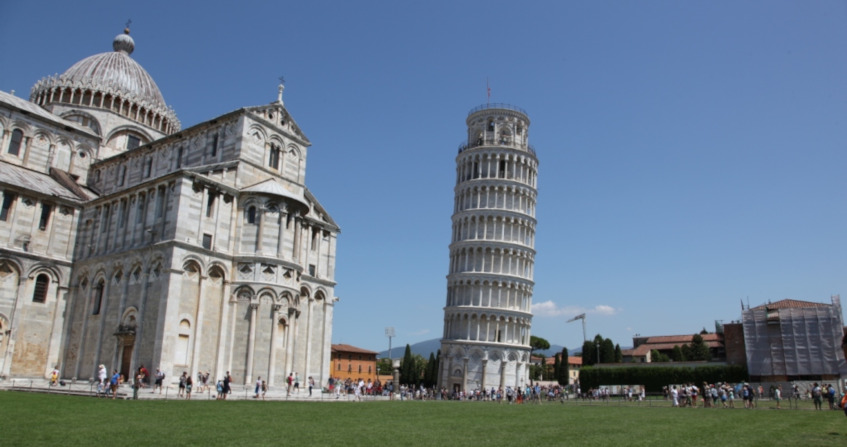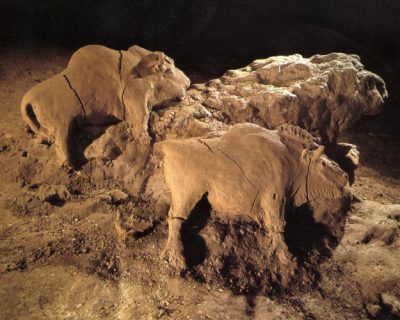黏土:令人惊讶的天然纳米材料

黏土是人们日常生活和所处环境中无处不在的一类材料。干燥时,像岩石一样坚硬;泥泞时,像油一样流动。如今黏土被用于建造大型建筑,且常构成城市地区的地基。那么,土木工程技术人员是如何克服黏土带来的困难呢?
1. 一种通用材料

[图片来源: Leroi-Gourhan Arlette, 1984: L’Art des cavernes: Atlas des grottes ornées paléolithiques françaises (CC BY-SA 4.0)]
如果有一种材料能与人类历史相混淆,那就是黏土。在《圣经》创世纪的第一章中提及,根据翻译,黏土、淤泥或土壤这几个词被用在如下语境中:“然后,上帝用地上的黏土造人,向他的鼻孔吹进了生命的气息,他就具有了生命。[1]”
毋庸置疑的是,黏土是促成艺术诞生的材料之一:在Tuc d’Audoubert(Ariège)史前洞穴中的野牛就是用湿黏土制成的。在1912年Begouën[2]发现的洞穴中,在没有烧制的情况下,这些模型能保持湿润达15000年(马格德林时期)。100%的相对湿度条件有利于这种保存(存在一些裂缝)[3](图1,[4])。
在公元前3000多年的乌尔和苏美尔时期,美索不达米亚的文字也通过黏土发展起来[5]。由誊写人用楔形文字刻制的泥板是人类历史上最早的文字痕迹。特别是公元前2000多年,《吉尔伽美什史诗》被记载在12块泥板上,讲述了乌鲁克国王的故事(图2,泥板XI,洪水)。

[图片来源:大英博物馆 (CC0)]
用黏土烧制陶器和炊具可以追溯到新石器时代的亚洲和新月沃土地区。在所有人类聚居区,对黏土与水的混合、脱水、无开裂收缩以及烧制的控制一直伴随着人类的发展。烧制而成的黏土的耐久性,得以让考古学家通过多种文明的陶器碎片来解读历史。
黏土也是一种奇妙的产品,自人类诞生之初,就被用于药典和化妆品中:例如,亚马逊印第安人的人体彩绘,用黏土制成的美容面具,如有机商店的绿石泥和温泉疗养地的泥浴。更常见的是,“索米耶尔之土”被用作天然去污剂或止泻药“思密达®”的基本成分。黏土也被用于制作牙膏、造纸业以及涂料填料。黏土普遍存在于我们的环境中,长期以来一直被广泛使用。

[图片来源: © BRGM]
图片3文字翻译:Mouvements de terrain différentiels consécutifs à la sécheresse et à la réhydratation des sols(土壤干旱和复水引起的不同地层活动);Nombre d’arrêtés de reconnaissance de l’état de catastrophe naturelle par commune au 23 janvier 2018(截至2018年1月23日,各城市发布的自然灾害状况的指令数)
最后,黏土是一种建筑材料,也许多建筑物的支撑材料。土制建筑,无论是土坯、柴泥或泥砖,在世界各地都很普遍。一些重要的建筑,如伊拉克的金字神塔,就使用了芦苇秸秆加固(参见“土壤加固:必不可少的技术”)。但是作为建筑的支撑,黏土也会带来很多问题。根据气候或水力条件的不同,其体积会因吸收水分或在干燥过程中收缩而发生变化:称之为干缩湿胀。在法国,自2003年以来的旱灾对独栋住宅和其他建筑造成了巨大的破坏:超过8500个城市已被认定处于自然灾害状态,这使得业主有机会通过保险获得赔偿。这些损害既不引人注目,也不是“媒体炒作”,它们不会对任何人造成事故,只会造成建筑物安全受损的重大裂缝。过去几年的总成本十分高昂:1990年至2013年[6]期间的总成本约为85亿欧元。图3地图发布了2.3万多条自然灾害指令的相关城市[7]。目前的全球变暖不会改善这种影响:根据截止到2100年的气候变化模型,2020-2100年期间,消除湿胀的成本可能在500亿到1000亿欧元之间。
2. 一种天然的纳米材料

[图片来源:Philippe REIFFSTECK]
图片4文字翻译:atome d’oxygène(氧原子);atome de silicium(硅原子);hydroxyle(羟基);atome d’aluminium(铝原子);Figure 4a:Couche de silicium(图4a:硅层);Figure 4b:Couche d’alumine(图4b:铝氧层)
黏土来源于硅质岩(特别是花岗岩)的物化蚀变。在受气候因子影响而分解的过程中,这些岩石会产生不同种类非常细小的黏土颗粒。在沉积之前,这些极细黏粒会被被冲刷和随之运移。这些黏土由层状排列、片状堆叠的硅(Si)、铝(Al)和羟基(OH)组成。在图4a中,SiO4四面体组装在一个梯形层中。八面体是由一个铝原子被六个羟基(OH)包围构成,并以矩形的层状形式存在(图4b)[8]。
两个或三个这样的基本单元构成一个单位晶层(图5)。高岭石(用于制作陶瓷)由硅片和铝片叠加而成,而蒙脱石是两个硅片夹一个铝片,再相互叠加而成。
不同的阳离子替代也常会发生,从而产生了不同的黏土矿物。

[图片来源:Philippe REIFFSTECK]
图片5文字翻译:Figure 5a:Feuillet de kaolinite [10](图5a:高岭石片[10]);n couches de H2O et cations échangeables(nH2O和可交换阳离子);Figure 5b: Montmorillonite [10]:(图5b:蒙脱石[10])
因此,镁离子(Mg2+)、钾离子(K+)、铁离子(Fe2+)可以根据风化条件或在粘土颗粒的沉积运输过程中取代铝离子(Al3+),形成蒙脱石等黏土矿物。
这些纳米级的晶层(10Å=1nm=10-9m)堆积形成黏土团聚体,黏土结构则以面-面或边-面键结合,可以呈现分散或聚集状态。这种堆积可由1到100个单位晶层组成。根据黏土性质的不同,在其晶层表面和晶层之间,可以通过电化学作用吸附水分子。对于层间键合较弱的蒙脱石来说尤其如此:这些电化学特性使得水主导黏土的特性,特别是在收缩和膨胀方面:水分子的吸附导致层间距加大和膨胀。
水和黏土间的这种相互作用源于黏粒的比表面:如果将一克[9]蒙脱石的所有单位晶层表面展开,将得到600平方米的面积(高岭石则为50平方米)。
黏土的含水量定义为:在105℃下干燥后,水质量与黏土质量的比值。它的变化范围从干燥粉末的0%到蒙脱石的超过300%或500%不等。墨西哥城的黏土沉积物的含水量超过300%(从150%到600%不等)[10]。
黏土的稠度因含水量的不同而不同,这就引出了“状态极限”或阿特伯格极限[11]的定义:液限和塑限。它们取决于矿物学性质,并在岩土工程中用于表征黏土。在液限以上,黏土表现出高黏度液体的特性(参见“物质是如何形变的——流体和固体”),而在塑限以下,黏土无法在不开裂的情况下成型。这些含水量的变化伴随着体积的变化。
天然冲积土由砂粒、粉粒和黏粒的混合物组成。土壤黏粒含量被定义为小于0.002毫米粒径颗粒的重量百分比。
3. 黏土和渗透性
黏土和黏土材料在土木工程中被广泛应用。黏土最有趣的特性之一是其低渗透性,比砂土低100万倍(参见“土壤中的扩散和渗透”(https://www.encyclopedie-environnement.org/en/zoom/diffusion-and-percolation-in-soils/))。废物储存中心采用夯实的黏土层作为密封层,将沉积物与外界环境隔离开来。一些产品将一厘米厚的膨润土层[13]与土工膜相结合。另一个应用则用于水坝和堤坝的建设。大型回填坝(如Serre-Ponçon和Grand Maison;参见“工程师眼中的土”)由不同的区域组成,且其密封性能由压实的黏土芯或含有充足黏粒的材料提供。堤坝、小型农业水坝、山坡水库和其他水库通常用夯实的黏土筑堤。
在法国东部,核废料的储存计划中采用了厚厚的黏土层:这是一种高度致密的黏土,超过500米深,其不透水性将确保放射性元素的封存[13]。
4. 固结和沉降

[图片来源:©Etienne Flavigny]
许多城市和大都市在山谷、河口、湖滨或海滨地区发展起来。这些地区的地基是由冲积物、砂浆、黏土和泥浆组成的。这些物质通常含水量较高,并在地质时代期间逐层沉积的沉积层重压下发生固结。这种固结是指在上层施加的应力作用下,孔隙水被排出(参见“物质是如何形变的——流体和固体”)。
当对建筑物表面进行施工时,会增加额外的压力,进而在建筑物结构的尺度上导致回填区域或城市区域的附加沉降。这个过程可以类比为果汁机(图6),其中果汁在螺杆对托盘施加的压力作用下[14]被挤压出来。
由于黏土的低渗透性,沉降的过程从几天到几个世纪不等。如下几个案例很有名。墨西哥城大教堂建于1560年,覆盖了一些阿兹特克神庙的遗址,这些神庙为了建造大教堂而被拆除。它的沉降达2.5 m以上,东西塔之间的沉降差[15]为1.25 m。多项保护工程已经开展,包括地下挖掘工程,这些工程涉及从井中进行挖掘,在沉降较少的一侧创建一个沉降(图7)。

[图片来源:Arian Zwegers,(CC BY 2.0),通过Flickr]

[图片来源:Thorfinn Stainforth (CC BY-SA 3.0),通过 Wikimedia commons]
这项技术也成功地被用于减少比萨斜塔的差异沉降:Burland等人[16]因而“复原”了其倾斜度,使其恢复到了300年前的数值。
目前的一个实例是大阪机场的停机坪[17](关西国际机场)。这是一座1.25×4公里的人工岛,建在水深18米处。预期沉降约为11米,允许将完成高度设定在海平面以上4米。然而观测到的沉降强度超出预期(约为14.3米),因此需要进行重大工程,提高周边的防波墙,并对建筑物进行修复。
在大城市,导致地基土壤压实的另一个原因是地下水位的降低:由于用水需求,需要将水泵入地下。这导致了沉降层水平的降低。曾经受到阿基米德力浮力作用的土层不再受到此作用的影响,其表观重量增加。这造成了超载,从而在整个区域引发沉降。于是我们谈论到场地的下沉问题。这种现象对曼谷[18]、上海和威尼斯的影响尤其明显。这种下沉现象加上海平面上升使得这些大都市地区更易遭受洪水的侵袭。
在岩土工程中,评估建筑物沉降是项目中得重要部分:建筑物会沉降多少,需要多长时间才能达到稳定状态?
5. 黏土的抗压性

[图片来源:BRGM]
图片5文字翻译:Zonage sismique de la France(法国地震区划图);en vigueur depuis le 1er mai 2011(自2011年5月1日起生效);(art. D. 563-8-1 du code de r’environnement)(《环境守则》第563-8-1条);
Zones de sismicite(地震带);très faible(非常弱);faible(弱);modérée(中等);moyenne(中强);forte(强)
岩土工程的另一方面是避免事故。要做到这一点,我们必须了解黏土的抗压性。这些材料具有粘聚力和摩擦角(参见“物质是如何形变的——流体和固体”)。其粘聚力类似于基本晶层之间的一种粘合现象,取决于黏土沉积物的含水量和历史;而摩擦角则与矿物学有关。这两个参数被用于建筑物结构基础、大坝、堤坝和基坑的稳定性计算中。当所施载荷超过黏土强度时,就会发生断裂。这种断裂可能在短期内发生,尤其是在建筑结束时,也可能在很长时间后发生。滑坡便是一个实例,其中黏土的抗压力是控制自然或人为斜坡稳定性的重要参数 (参见“滑坡”)。在质量低劣或强度不足的黏土上建造房屋,促进了土壤改良技术的发展(参见“土壤加固:必不可少的技术”),以增加抗力并减少沉降。
对于地下土层含有黏土冲积层的城市而言,地震可能带来相当大的诱发效应:我们称之为“场地效应”[19]。地震波会被困在黏土层中并被放大。1985年,发生在墨西哥城的毁灭性地震就是一个实例:虽然这次地震的震中距离较远,但地震应力在墨西哥城中部被放大了,这是因为墨西哥城建在含有极高含水量和低粘聚力的黏土沉积物上。对这一现象的关注已纳入法国的地震区划中;日内瓦-安纳西-格勒诺布尔-巴伦西亚阿尔卑斯海沟地区位于大都市中最强的4号地震活动带[20](图9):极厚的细颗粒黏土冲积层的存在解释了这种分区。
6. 需记忆的要点
- 黏土在自然界中随处可见。
- 黏土的研究是多科学技术的交叉。
- 黏土的性质源于它们的层状结构。
- 黏土存在于冲积土的底层中,给土木工程结构带来了困难。
参考资料及说明
封面照片:比萨斜塔[Source: Kiste11 (CC BY-SA 4.0)]
[1] 《圣经》,1965年;耶路撒冷圣经学院,Desclée de Brouwer出版社。
[2] Bégouën H. (1912) Les statues d’argile préhistoriques de la caverne du Tuc d’Audoubert (Ariège), Comptes rendus des séances de l’Académie des Inscriptions et Belles-Lettres, Volume 56, Numéro 7, pp. 532-538, http://www.persee.fr/doc/crai_00650536_1912_num_56_7_73103
[3] 相对湿度是空气中水蒸气的实际含量与同温度下的饱和湿度之比。相对湿度的范围从完全干燥的空气的0%到形成水滴的高于100%。
[4] Leroi-Gourhan A. (1984) L’Art des cavernes : Atlas des grottes ornées paléolithiques françaises.
[5] Kramer S.N., 2017, L’histoire commence à Sumer, Flammarion.
[6] Gourdier S., Plat E. (2018) Impactdu changement climatique sur la sinistralité due au retrait-gonflement des argiles, Journées Nationales de Géotechnique et de Géologie de l’Ingénieur, ENPC, Marne-la-Vallée, https://hal-brgm.archives-ouvertes.fr/hal-01768395
[7] http://infoterre.brgm.fr/page/alea-retrait-gonflement.
[8] Reiffsteck P., Zerhouni M., Averlan J-L ( 2018), Essais de laboratoire pour la mécanique des sols et la géotechnique, Presses de l’ENPC, Paris.
[9] 一克大约相当于一小匙绿色黏土的质量。
[10] Ovando E. (2011), Some geotechnical properties to characterize Mexico City Clay, http://geoserver.ing.puc.cl/info/conferences/PanAm2011/panam2011/pdfs/GEO11Paper889.pdf
[11] https://en.wikipedia.org/wiki/Albert_Atterberg
[12] 膨润土是一种蒙脱土,被广泛应用于土木工程或石油工程的钻探。
[14] 这里的约束条件是施加的力除以榨汁机的截面积。
[15] 不均匀沉降指建筑物的两个地基之间存在沉降差,从而导致开裂。
[16] Burland, J.B., Jamiolkowski, M., Viggiani C. (1998), Stabilizing the leaning tower of Pisa, Bulletin of Engineering Geology and Environnement, n°57 pp.91-99.
[17] Puzrin, A.M., Alonso E.E., Pinyol N.M. (2010), Geomechanics of failures, Springer.
[18] Phien-wej N., Giao P.H., Nutalaya P. (2006), Land subsidence in Bangkok, Thaïland, In Engineering Geology, Volume 82, Issue 4, Pages 187-201, ISSN 0013-7952, https://doi.org/10.1016/j.enggeo.2005.10.004.(http://www.sciencedirect.com/science/article/pii/S0013795205002693
[19] Bard, P.-Y. (2002), Les effets de site et la cuvette grenobloise, Risques-Infos n°13, IRMA Grenoble, Mai 2002
[20] Zonage sismique de la France. http://www.planseisme.fr/Zonage-sismique-de-la-France.html
环境百科全书由环境和能源百科全书协会出版 (www.a3e.fr),该协会与格勒诺布尔阿尔卑斯大学和格勒诺布尔INP有合同关系,并由法国科学院赞助。
引用这篇文章: FLAVIGNY Etienne (2024年3月4日), 黏土:令人惊讶的天然纳米材料, 环境百科全书,咨询于 2025年4月6日 [在线ISSN 2555-0950]网址: https://www.encyclopedie-environnement.org/zh/sol-zh/clay-a-natural-and-surprising-nanomaterial/.
环境百科全书中的文章是根据知识共享BY-NC-SA许可条款提供的,该许可授权复制的条件是:引用来源,不作商业使用,共享相同的初始条件,并且在每次重复使用或分发时复制知识共享BY-NC-SA许可声明。






